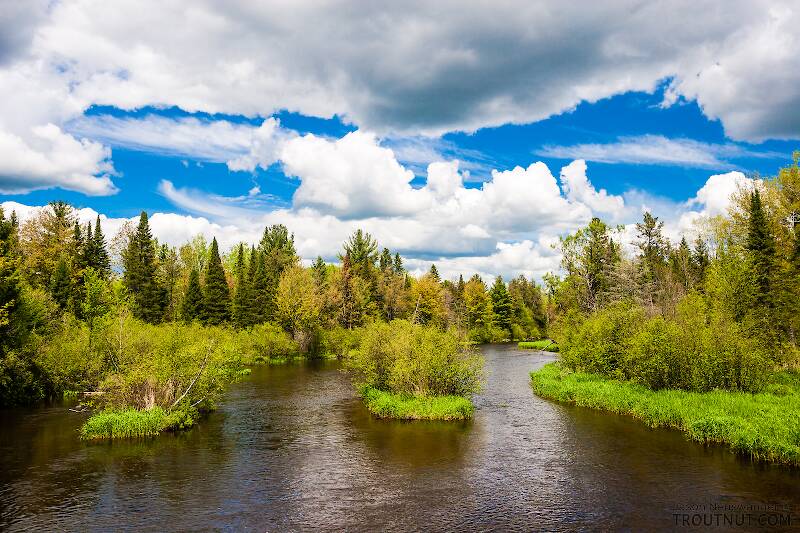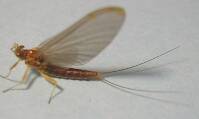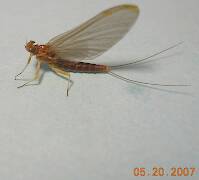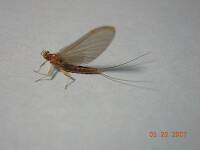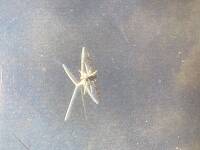
Hex Mayflies
Hexagenia limbata
The famous nocturnal Hex hatch of the Midwest (and a few other lucky locations) stirs to the surface mythically large brown trout that only touch streamers for the rest of the year.
Featured on the forum

This specimen resembled several others of around the same size and perhaps the same species, which were pretty common in my February sample from the upper Yakima. Unfortunately, I misplaced the specimen before I could get it under a microscope for a definitive ID.

Troutnut is a project started in 2003 by salmonid ecologist Jason "Troutnut" Neuswanger to help anglers and
fly tyers unabashedly embrace the entomological side of the sport. Learn more about Troutnut or
support the project for an enhanced experience here.
Wiflyfisher has attached these 2 pictures to aid in identification. The message is below.
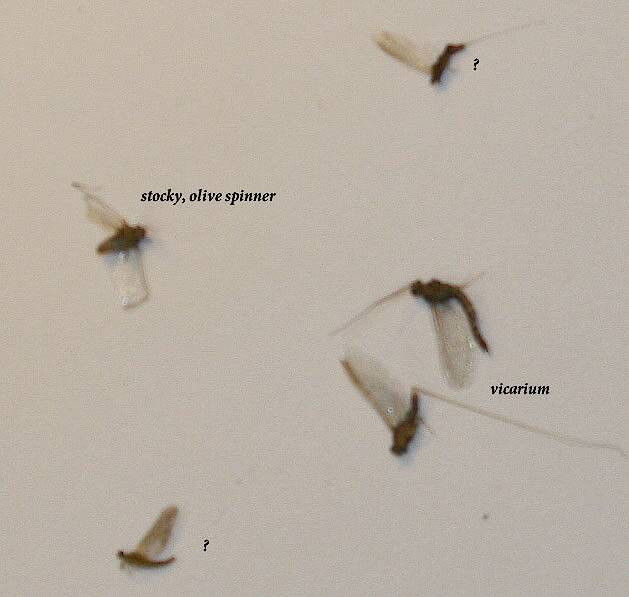
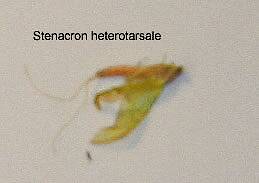
Wiflyfisher on Jun 14, 2008June 14th, 2008, 12:43 am EDT
Last night there was a wide variety of different duns and spinners on the water. Before focusing on catching trout I stood in the stream and grabbed a few bugs. Here is my questions to you guys? (I don't have all my books with me to look them up.)
1. A small spinner that is dark olive and very stocky body, about a size #16. Could is be Ephemerella glacialis?
2. A small dun about the size of dorothea but dark olive with burnt orange eyes. Could it be Ephemerella inermis or needhami?
3. Another dun, barred yellow wings, light pinkish-orange abdomen and olive thorax (#12 standard dry). Could it be Stenacron heterotarsale?
The preferred trout meal was S. fuscum duns last night. What is that called now?
1. A small spinner that is dark olive and very stocky body, about a size #16. Could is be Ephemerella glacialis?
2. A small dun about the size of dorothea but dark olive with burnt orange eyes. Could it be Ephemerella inermis or needhami?
3. Another dun, barred yellow wings, light pinkish-orange abdomen and olive thorax (#12 standard dry). Could it be Stenacron heterotarsale?
The preferred trout meal was S. fuscum duns last night. What is that called now?
John S.
https://WiFlyFisher.com
https://WiFlyFisher.com
Konchu on Jun 14, 2008June 14th, 2008, 1:30 am EDT
1) No. E. glacialis is an old name for Drunella grandis, a large and western species.
2) Could be inermis or needhami. I'd guess inermis.
3) sounds reasonable.
4) S. fuscum now is Maccaffertium vicarium.
2) Could be inermis or needhami. I'd guess inermis.
3) sounds reasonable.
4) S. fuscum now is Maccaffertium vicarium.
Wiflyfisher on Jun 14, 2008June 14th, 2008, 2:25 am EDT
Konchu,
1. If it can't be E. glacialis than what mayfly spinner is in the Upper Midwest and has about 1/4" long, dark greenish-olive body that is very stocky? This bugger is very short and chubby compared to most sleek spinners.
3. Is it still called "Stenacron heterotarsale"?
Hopefully you are not flooded out in Indy!
Thanks,
1. If it can't be E. glacialis than what mayfly spinner is in the Upper Midwest and has about 1/4" long, dark greenish-olive body that is very stocky? This bugger is very short and chubby compared to most sleek spinners.
3. Is it still called "Stenacron heterotarsale"?
Hopefully you are not flooded out in Indy!
Thanks,
John S.
https://WiFlyFisher.com
https://WiFlyFisher.com
GONZO on Jun 14, 2008June 14th, 2008, 4:23 am EDT
John,
1. You're probably seeing Drunella lata. Jason has some pix of lata (cornuta) and either tuberculata or walkeri. These are all stocky mayflies, the latter species especially so. See if anything there rings a bell. (I suspect the lata spinner photos might be the ticket. The male spinners are often a darker, blackish olive.)
2. Stenacron heterotarsale is one of the species now synonomized with Stenacron interpunctatum.
BTW, Roger's website has some very handy tools for updating taxonomy, including updates for many older fly-fishing books, or you could check the species lists on Mayfly Central.
1. You're probably seeing Drunella lata. Jason has some pix of lata (cornuta) and either tuberculata or walkeri. These are all stocky mayflies, the latter species especially so. See if anything there rings a bell. (I suspect the lata spinner photos might be the ticket. The male spinners are often a darker, blackish olive.)
2. Stenacron heterotarsale is one of the species now synonomized with Stenacron interpunctatum.
BTW, Roger's website has some very handy tools for updating taxonomy, including updates for many older fly-fishing books, or you could check the species lists on Mayfly Central.
Wiflyfisher on Jun 14, 2008June 14th, 2008, 1:52 pm EDT
Gonzo,
1. It is not lata, but I do think it is Drunella. Unfortunately, it was sort of distorted in my flybox and I had to leave for a few days because of all the rain back home. :(
I use Roger's taxonomy as my resource, but I get lazy at times.
What we need are online regional (West, Midwest,East) color plates, divided into 3 sections: nymphs, duns & spinners. The thumbnail images would have photos of the actual common bugs. This would help quickly identify mayflies, or at least rule out certain ones. Over the many years I found Caucci & Natasi's Mayfly Pocket Guide the best quick, visual reference for me on stream and off. Unfortunately, I go back to '79 and before and I learned by all the older names and Konchu (and others) changed all those names on me and now I am all messed up. :(
The one good thing is at least I know the insect's habits and behaviors so I am not toally lost while fishing, just collecting throws me.
1. It is not lata, but I do think it is Drunella. Unfortunately, it was sort of distorted in my flybox and I had to leave for a few days because of all the rain back home. :(
I use Roger's taxonomy as my resource, but I get lazy at times.
What we need are online regional (West, Midwest,East) color plates, divided into 3 sections: nymphs, duns & spinners. The thumbnail images would have photos of the actual common bugs. This would help quickly identify mayflies, or at least rule out certain ones. Over the many years I found Caucci & Natasi's Mayfly Pocket Guide the best quick, visual reference for me on stream and off. Unfortunately, I go back to '79 and before and I learned by all the older names and Konchu (and others) changed all those names on me and now I am all messed up. :(
The one good thing is at least I know the insect's habits and behaviors so I am not toally lost while fishing, just collecting throws me.
John S.
https://WiFlyFisher.com
https://WiFlyFisher.com
Taxon on Jun 14, 2008June 14th, 2008, 2:24 pm EDT
Hi John-
Just got access to a copy recently, but I certainly agree with your assessment. As soon as I can get around to it, I'll provide an updated taxonomy for it. Maybe I can also create a foldout version of the updated taxonomy, which could be attached to the inside of the back cover.
Over the many years I found Caucci & Natasi's Mayfly Pocket Guide the best quick, visual reference for me on stream and off.
Just got access to a copy recently, but I certainly agree with your assessment. As soon as I can get around to it, I'll provide an updated taxonomy for it. Maybe I can also create a foldout version of the updated taxonomy, which could be attached to the inside of the back cover.
Wiflyfisher on Jun 14, 2008June 14th, 2008, 2:37 pm EDT
Roger, that would be terrific!
So you guys know, I just uploaded the only photo I have of the mayflies I grabbed last night. Although blurry you will see the short stocky spinner I have never seen before on this river.
So you guys know, I just uploaded the only photo I have of the mayflies I grabbed last night. Although blurry you will see the short stocky spinner I have never seen before on this river.
John S.
https://WiFlyFisher.com
https://WiFlyFisher.com
Wiflyfisher on Jun 14, 2008June 14th, 2008, 2:50 pm EDT
As a side note, I had a 17" brown that I hooked leap so high I thought he set a new Olympic record and the barbless hook held until I got him in the net, which was great since I was releasing him anyway.
John S.
https://WiFlyFisher.com
https://WiFlyFisher.com
Taxon on Jun 14, 2008June 14th, 2008, 3:11 pm EDT
John-
Can't see it very well, but my impression is that it looks so stocky because a major portion of the abdomen is missing.
Although blurry you will see the short stocky spinner I have never seen before on this river.
Can't see it very well, but my impression is that it looks so stocky because a major portion of the abdomen is missing.
Wiflyfisher on Jun 14, 2008June 14th, 2008, 3:16 pm EDT
Can't see it very well, but my impression is that it looks so stocky because a major portion of the abdomen is missing.
Roger, when I got him on the river that was his size, nothing missing. The tails are missing from bouncing around in my flybox in my vest and I don't remember how many tails.
John S.
https://WiFlyFisher.com
https://WiFlyFisher.com
GONZO on Jun 14, 2008June 14th, 2008, 6:50 pm EDT
John,
After seeing the photo, I agree that the chubby mystery spinner does seem too fat for lata. Perhaps it is tuberculata or walkeri. Both are fatter than lata, but I don't know if they are found in Wisconsin. Have you considered Baetisca as a possibility?
After seeing the photo, I agree that the chubby mystery spinner does seem too fat for lata. Perhaps it is tuberculata or walkeri. Both are fatter than lata, but I don't know if they are found in Wisconsin. Have you considered Baetisca as a possibility?
Wiflyfisher on Jun 15, 2008June 15th, 2008, 2:01 am EDT
It might be Baetisca laurentina, which Jason witnessed during M. vicarium and E. invaria spinnerfalls on another river close by. I need to find some specs on the Baetisca species.
John S.
https://WiFlyFisher.com
https://WiFlyFisher.com
Taxon on Jun 15, 2008June 15th, 2008, 6:45 am EDT
GONZO on Jun 15, 2008June 15th, 2008, 10:11 am EDT
John and Roger, the more I look at the photo, the more I am convinced that it probably is a female Baetisca spinner.
Wiflyfisher on Jun 15, 2008June 15th, 2008, 10:53 am EDT
I too believe it is Baetisca spinner now. What bothers me is I have never seen the Baetisca dun before in all my years on this river, which would be very obvious if I saw one. Also, the color was definitely a darker olive, not dark reddish brown with a tinge of olive.
But I guess when I see how they have combined so many different Stenonema variations all into one M. vicarium this would be called just another Baetisca spinner variation.
Also, it may be only on the upper portion of the river where the water is slightly colder and a slightly different terrain.
Thanks Roger & Gonzo.
But I guess when I see how they have combined so many different Stenonema variations all into one M. vicarium this would be called just another Baetisca spinner variation.
Also, it may be only on the upper portion of the river where the water is slightly colder and a slightly different terrain.
Thanks Roger & Gonzo.
John S.
https://WiFlyFisher.com
https://WiFlyFisher.com
Quick Reply
Related Discussions
Topic
Replies
Last Reply
4
May 24, 2008
by Softhackle
by Softhackle
0
Jun 12, 2006
by Troutnut
by Troutnut
3
Jun 17, 2017
by JohnR
by JohnR
0
Oct 24, 2006
by Troutnut
by Troutnut

